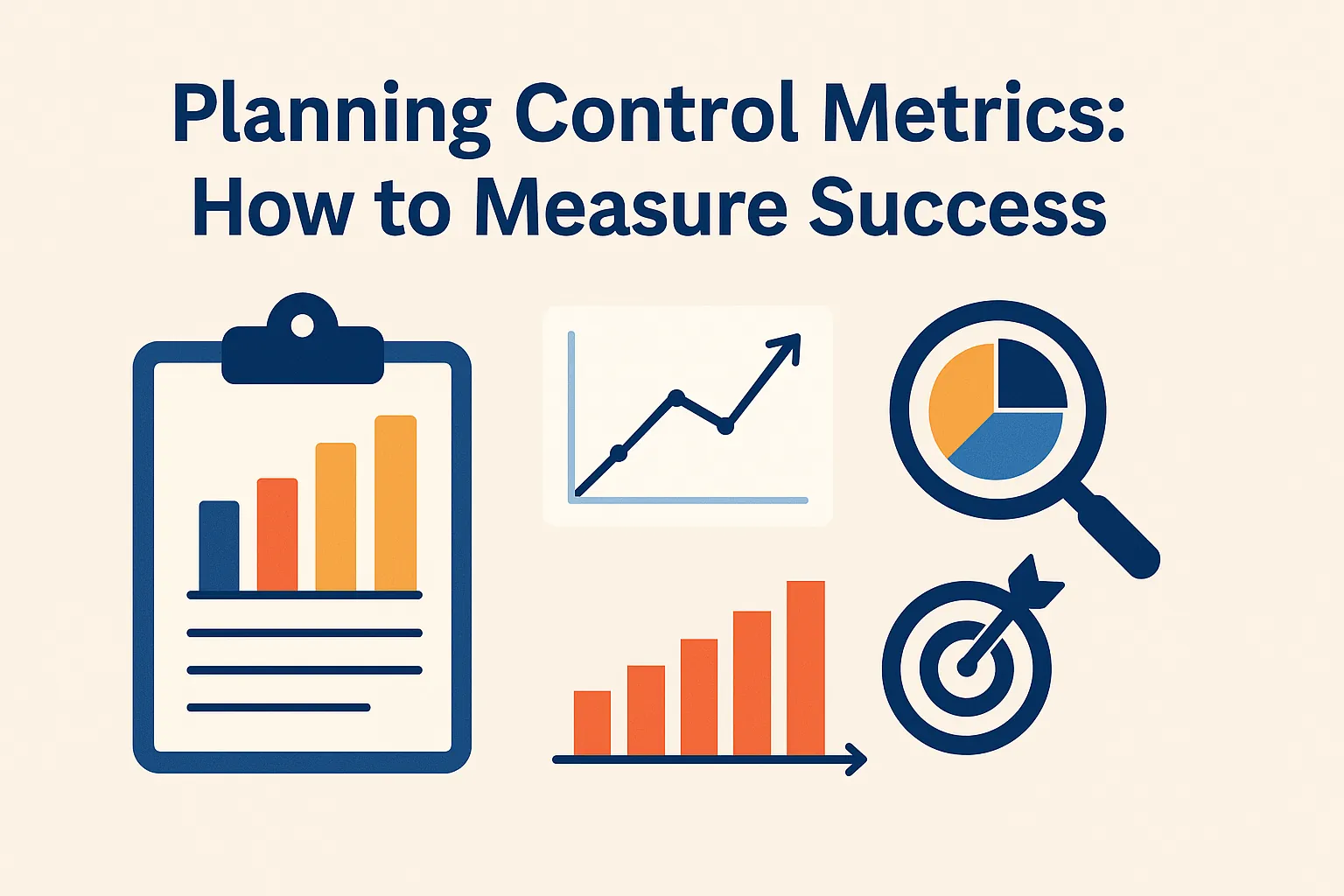Introduction to Planning Control
Planning control serves as a critical framework that ensures projects are executed according to predefined objectives, timelines, and budgets. It encompasses the processes and methodologies used to monitor and adjust project plans, ensuring that the project remains on track and aligned with its goals.
- Definition and Role: Planning control can be defined as the systematic approach to managing project plans, which includes the establishment of baselines, monitoring progress, and implementing corrective actions when necessary. This process is vital for project managers as it allows them to anticipate potential issues, allocate resources effectively, and make informed decisions that drive project success [1][2].
- Significance in Achieving Project Success: The importance of planning control cannot be overstated. It acts as a safeguard against deviations from the project plan, which can lead to delays, budget overruns, and ultimately, project failure. By maintaining a robust planning control system, project managers can ensure that all project activities are aligned with strategic objectives, thereby enhancing the likelihood of delivering projects on time and within budget [3][4]. Effective planning control also fosters better communication among stakeholders, as it provides a clear framework for reporting progress and addressing challenges as they arise [5].
- Metrics and KPIs for Assessment: To effectively assess the effectiveness of planning control, project managers rely on various metrics and Key Performance Indicators (KPIs). These quantifiable measures provide insights into how well the project is adhering to its planned schedule, budget, and quality standards. Common KPIs in this context include schedule variance, cost variance, and earned value metrics, which help in evaluating the overall health of the project and identifying areas that require attention [6][7]. By leveraging these metrics, project managers can make data-driven decisions that enhance planning control and contribute to the successful delivery of projects [8][9].
Understanding Key Performance Indicators (KPIs)
Key Performance Indicators (KPIs) serve as essential tools for measuring and evaluating the success of various project aspects, including planning control. KPIs provide project managers and data analysts with valuable insights into project performance, enabling them to make informed decisions and enhance project outcomes.
Definition and Importance of KPIs
KPIs are specific measurement methods that indicate how effectively teams are reaching their specified targets. They are crucial for monitoring progress and identifying areas for improvement throughout the project lifecycle. By utilizing KPIs, project managers can unveil weaknesses in their projects, such as inefficiencies in processes or issues with task assignments, which could potentially lead to project failure [2][6]. The importance of KPIs in project management lies in their ability to provide a clear framework for assessing performance, ensuring that projects remain aligned with their goals and objectives [10][15].
Quantitative vs. Qualitative KPIs
KPIs can be categorized into two main types: quantitative and qualitative.
- Quantitative KPIs are numerical indicators that can be measured and analyzed statistically. Examples include metrics such as Cost Performance Index (CPI), project schedule variance, and budget variance. These metrics provide concrete data that can be used to assess project efficiency and effectiveness [1][8].
- Qualitative KPIs, on the other hand, focus on non-numerical aspects of project performance. These may include client satisfaction, team morale, and stakeholder engagement. While qualitative KPIs are more subjective, they are equally important as they provide insights into the overall health of the project and the satisfaction of those involved [3][4].
Characteristics of Effective KPIs
For KPIs to be effective in assessing planning control, they should possess certain characteristics:
- Specificity: Effective KPIs should be clearly defined and focused on specific aspects of project performance. This clarity helps in accurately measuring progress and identifying areas for improvement [11].
- Measurability: KPIs must be quantifiable, allowing project managers to track performance over time and make data-driven decisions. This includes both quantitative and qualitative measures that can be assessed through various methods [12].
- Relevance: KPIs should align with the project’s goals and objectives, ensuring that they provide meaningful insights into performance. This relevance helps project managers prioritize their efforts and resources effectively [13].
- Actionability: Effective KPIs should lead to actionable insights. They should not only highlight areas of success but also indicate where corrective actions are needed to enhance project performance [14].
Identifying Relevant KPIs for Planning Control
Effective planning control is crucial for ensuring that projects are completed on time, within budget, and to the desired quality standards. Key Performance Indicators (KPIs) serve as essential tools for measuring the effectiveness of planning control. Here, we will explore common KPIs, how to align them with project goals, and provide examples of industry-specific KPIs.
Common KPIs Used in Planning Control
- Schedule Variance (SV): This KPI measures the difference between the planned project schedule and the actual progress made. A positive SV indicates that the project is ahead of schedule, while a negative SV suggests delays [8].
- Cost Variance (CV): CV assesses the difference between the budgeted cost of work performed and the actual cost incurred. A positive CV indicates that the project is under budget, while a negative CV signals overspending [8].
- Resource Utilization: This metric evaluates how effectively project resources (human, financial, and material) are being used. High resource utilization rates can indicate efficient planning, while low rates may suggest underutilization or inefficiencies [12].
- Cost Performance Index (CPI): The CPI measures cost efficiency by comparing the budgeted cost of work performed to the actual cost. A CPI greater than 1 indicates that the project is performing well financially [1].
- Planned Value (PV): This KPI represents the value of work that was planned to be completed by a specific time. It helps project managers assess whether the project is on track according to the original schedule [13].
Aligning KPIs with Project Goals and Objectives
To effectively measure planning control, it is essential to align KPIs with the specific goals and objectives of the project. Here are some strategies to achieve this alignment:
- Define Clear Objectives: Start by establishing clear, measurable objectives for the project. This will provide a foundation for selecting relevant KPIs that directly reflect the project’s success criteria [10].
- Involve Stakeholders: Engage key stakeholders in the KPI selection process to ensure that the chosen indicators reflect their priorities and expectations. This collaboration can lead to a more comprehensive understanding of what success looks like for the project [12].
- Regularly Review and Adjust: As the project progresses, regularly review the relevance of the selected KPIs. Adjust them as necessary to reflect any changes in project scope, objectives, or external factors that may impact performance [11].
Industry-Specific KPIs
Different types of projects may require specific KPIs to accurately assess planning control effectiveness. Here are examples of industry-specific KPIs:
Construction Projects:
- Construction Time & Cost: Measures the actual time and cost against the planned estimates, providing insights into project efficiency [3].
- Defects Rate: Tracks the number of defects or issues identified during construction, which can indicate quality control effectiveness [3].
IT Projects:
- Functionality Delivered: Assesses the percentage of planned features or functionalities that have been successfully implemented [12].
- User Acceptance Testing (UAT) Success Rate: Measures the percentage of features that pass user acceptance testing, reflecting the project’s alignment with user needs [12].
Marketing Projects:
- Return on Investment (ROI): Evaluates the financial return generated from marketing activities compared to the costs incurred [4].
- Customer Satisfaction Scores: Measures the satisfaction level of customers with the marketing campaign, providing insights into its effectiveness [4].
By carefully selecting and aligning KPIs with project goals, project managers can effectively measure the success of their planning control efforts, leading to improved project outcomes and stakeholder satisfaction.
Measuring Success: Data Collection and Analysis
Effective planning control is crucial for ensuring that projects are delivered on time, within budget, and to the desired quality standards. To assess the effectiveness of planning control, project managers and data analysts must rely on key performance indicators (KPIs) that provide insights into project performance. This section outlines methods for data collection and analysis that are essential for measuring planning control effectiveness.
Data Sources for KPI Measurement
To accurately measure KPIs, project managers can utilize a variety of data sources:
- Project Management Software: Tools like Microsoft Project, Asana, or Trello can provide real-time data on project timelines, resource allocation, and task completion rates. These platforms often include built-in reporting features that help track progress against planned objectives [1].
- Stakeholder Feedback: Gathering input from stakeholders through surveys, interviews, or focus groups can provide qualitative data that complements quantitative metrics. This feedback can highlight areas of concern or success that may not be immediately evident from numerical data alone [1].
- Administrative Records: Recording data through administrative actions during project implementation is a common method for data collection. This includes documentation of project changes, resource usage, and financial expenditures, which can be analyzed to assess planning control [3].
Importance of Real-Time Data
Real-time data is vital for timely decision-making in project management. It allows project managers to:
- Identify Trends and Patterns: By continuously monitoring KPIs, project managers can detect changes in project performance, such as marked increases or decreases in key metrics over time. This enables proactive adjustments to be made before issues escalate [5][7].
- Facilitate Quick Interventions: Access to up-to-date information allows for immediate responses to deviations from the project plan. This agility is essential for maintaining project momentum and ensuring that objectives are met [6].
Tools and Techniques for Analyzing KPI Data
Once data is collected, various tools and techniques can be employed to analyze KPI data effectively:
- Statistical Techniques: Utilizing statistical methods can help project managers understand the significance of the data collected. Techniques such as variance analysis can reveal discrepancies between planned and actual performance, guiding necessary corrective actions [6][11].
- Qualitative Coding: For qualitative data gathered from stakeholder feedback, qualitative coding can be used to categorize and analyze responses. This method helps in identifying common themes and insights that can inform planning control strategies [11].
- Comparative Assessments: Comparing KPI data against benchmarks or historical data can provide context for current performance. This analysis can help project managers understand how their projects stack up against industry standards or past projects, facilitating informed decision-making [11].
Evaluating Planning Control Effectiveness
Evaluating Planning Control Effectiveness
In project management, effective planning control is crucial for ensuring that projects are completed on time, within budget, and to the desired quality standards. To assess the effectiveness of planning control, project managers and data analysts can utilize Key Performance Indicators (KPIs). These metrics provide a quantifiable means of measuring progress and performance, allowing teams to make informed decisions and adjustments as necessary.
Interpreting KPI Results in the Context of Project Performance
KPIs serve as vital indicators of how well a project is adhering to its planned objectives. Some key KPIs relevant to planning control include:
- Project Schedule Variance: This measures the difference between the planned timeline and the actual timeline. A negative variance indicates delays, while a positive variance suggests that the project is ahead of schedule [1].
- Cost Performance Index (CPI): This assesses cost efficiency by comparing the budgeted cost of work performed to the actual cost. A CPI greater than 1 indicates that the project is under budget, while a CPI less than 1 suggests overspending [1][12].
- Earned Value: This metric combines scope, schedule, and cost to provide a comprehensive view of project performance. It helps in understanding how much work has been completed compared to what was planned [4].
Interpreting these KPIs requires a contextual understanding of the project’s goals and constraints. For instance, a project may have a high CPI but a negative schedule variance, indicating that while costs are controlled, the project is falling behind schedule. This dual analysis allows project managers to identify specific areas needing attention.
Benchmarks and Standards for KPI Evaluation
Establishing benchmarks is essential for evaluating KPI results effectively. Benchmarks can be derived from:
- Historical Data: Analyzing past projects within the same organization or industry can provide a baseline for expected performance levels. This historical context helps in setting realistic targets for current projects [3].
- Industry Standards: Many industries have established norms for project performance metrics. For example, construction projects often aim for a CPI of 1.0 or higher and a schedule variance that remains within a certain percentage of the planned timeline [2].
- Best Practices: Organizations can develop their own best practices based on successful project outcomes. These practices can serve as a reference point for evaluating current project performance against established KPIs [11].
By comparing current KPI results against these benchmarks, project managers can assess whether their planning control measures are effective or if adjustments are needed.
Case Studies of Successful Planning Control Assessment
- Construction Project: A large-scale construction project implemented a rigorous KPI tracking system that included schedule variance and cost performance metrics. By regularly reviewing these KPIs, the project team identified potential delays early and adjusted resource allocation accordingly. As a result, the project was completed two weeks ahead of schedule and 5% under budget, demonstrating the effectiveness of their planning control measures [2].
- IT Development Project: In an IT development project, the team utilized earned value management to track progress. By comparing planned value against actual performance, they were able to identify a trend of increasing costs. This prompted a review of project scope and resource allocation, leading to a strategic pivot that ultimately brought the project back on track. The successful adjustment highlighted the importance of continuous KPI monitoring in planning control [4][11].
- Manufacturing Initiative: A manufacturing company adopted a KPI framework focusing on productivity and defect rates. By benchmarking against industry standards, they were able to reduce defects by 30% over six months. This case illustrates how effective planning control, guided by relevant KPIs, can lead to significant improvements in operational efficiency [2][3].
Continuous Improvement in Planning Control
Effective planning control is crucial for ensuring that projects are completed on time, within budget, and to the desired quality standards. One of the most effective ways to enhance planning control is through the use of Key Performance Indicators (KPIs). These metrics not only provide a quantifiable means of measuring performance but also serve as a foundation for continuous improvement. Here’s how project managers and data analysts can leverage KPI results to refine their planning control strategies.
Using KPI Results to Identify Areas for Improvement
KPIs are essential tools that help project managers assess the effectiveness of their planning control processes. By analyzing KPI data, teams can pinpoint specific areas that require attention. For instance, metrics such as Schedule Variance (SV) and Cost Performance Index (CPI) can reveal discrepancies between planned and actual performance, highlighting where adjustments are necessary.
- Schedule Variance (SV): This metric measures the difference between the planned timeline and the actual timeline, allowing project managers to identify delays and take corrective actions promptly [1].
- Cost Performance Index (CPI): This assesses cost efficiency by comparing the budgeted cost of work performed to the actual cost, helping teams understand financial performance and identify overspending areas [1].
By regularly reviewing these KPIs, project managers can make informed decisions that lead to improved planning processes and overall project success.
The Plan-Do-Check-Act (PDCA) Cycle in Planning Control
The Plan-Do-Check-Act (PDCA) cycle is a fundamental concept in continuous improvement that can be effectively applied to planning control. This iterative process encourages project teams to:
- Plan: Define objectives and identify the necessary actions to achieve them.
- Do: Implement the planned actions on a small scale to test their effectiveness.
- Check: Monitor and evaluate the results against the expected outcomes using KPIs.
- Act: Based on the evaluation, make necessary adjustments to improve the planning process.
By integrating the PDCA cycle into their planning control strategies, project managers can foster a culture of continuous improvement, ensuring that lessons learned from each project phase are applied to future initiatives [12].
The Role of Feedback Loops in Refining Planning Control Strategies
Feedback loops are critical in the context of planning control as they facilitate the ongoing refinement of strategies based on real-time data. By establishing mechanisms for collecting feedback from team members and stakeholders, project managers can gain insights into the effectiveness of their planning processes.
- Regular Reviews: Conducting regular reviews of KPI data allows teams to assess what is working and what is not, enabling timely adjustments to be made [11].
- Stakeholder Input: Engaging stakeholders in the feedback process ensures that diverse perspectives are considered, leading to more comprehensive planning strategies.
Incorporating feedback loops into the planning control framework not only enhances the responsiveness of project teams but also promotes a proactive approach to identifying and addressing potential issues before they escalate [14].
Conclusion
The significance of Key Performance Indicators (KPIs) in assessing planning control cannot be overstated. KPIs serve as essential tools that allow project managers to evaluate the effectiveness of their planning processes, ensuring that projects remain on track and aligned with their objectives. By measuring aspects such as schedule variance, cost performance, and resource utilization, project managers can gain valuable insights into their project’s health and make informed decisions to drive success [1][10].
Adopting a metrics-driven approach is crucial for project managers and data analysts alike. This approach not only enhances accountability but also fosters a culture of continuous improvement within project teams. By regularly monitoring and analyzing KPIs, project managers can identify potential risks early, optimize resource allocation, and ultimately improve project outcomes. Embracing this mindset will empower teams to respond proactively to challenges and adapt their strategies as needed [11][14].
For those looking to deepen their understanding of planning control metrics and their implementation, numerous resources are available. Books, online courses, and industry publications can provide further insights into effective KPI development and usage. Additionally, various project management software tools offer built-in functionalities for tracking and analyzing KPIs, making it easier for teams to integrate these metrics into their workflows. By leveraging these resources, project managers can enhance their planning control processes and drive their projects toward successful completion [2][12][15].
In summary, the implementation of effective planning control metrics is vital for project success. By recognizing the importance of KPIs, adopting a metrics-driven approach, and utilizing available resources, project managers can significantly improve their planning control effectiveness and achieve their project goals.
Find out more about Shaun Stoltz https://www.shaunstoltz.com/about/.
This post was written by an AI and reviewed/edited by a human.



